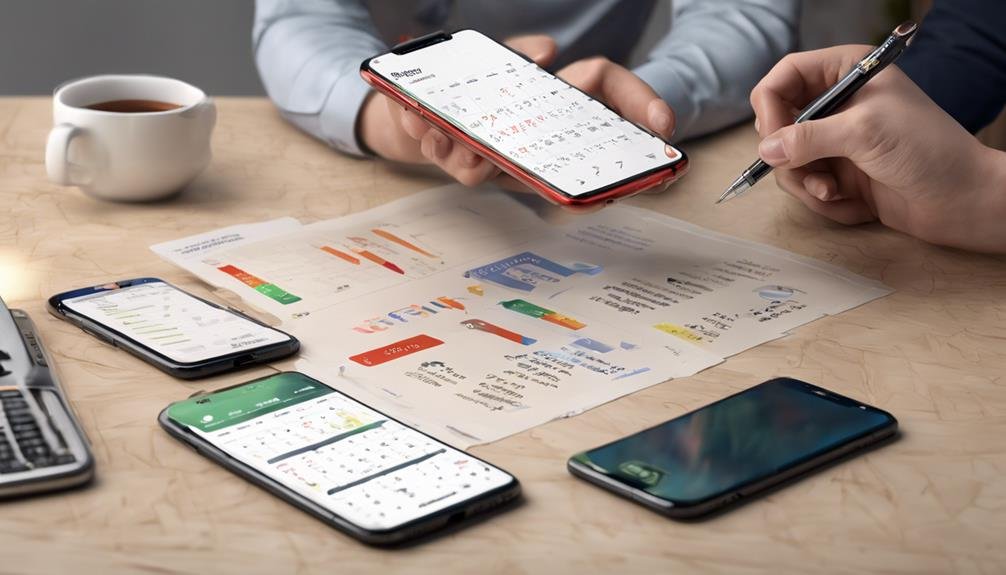Auto Insurance: How to Get the Best Rates
To get the best auto insurance rates, first understand your state's requirements. Compare quotes from various providers and negotiate for better rates. Your driving record impacts premiums, so keep it clean. Seek out discounts for multi-car policies, safe driving, and more. Adjust coverage levels wisely to balance protection with cost. Bundle policies to save money. Consider usage-based insurance for personalized premiums. Professional advice can offer valuable insights. These steps can help you secure the best rates for your auto insurance needs and make sure you are adequately covered.
Key Takeaways
- Compare quotes from multiple providers for the best rates.
- Utilize discounts like safe driver, multi-policy, and good student.
- Maintain a clean driving record for lower premiums.
- Consider adjusting coverage levels to balance cost and protection.
- Explore bundling policies for additional savings.
Understanding Insurance Requirements
To guarantee you meet legal obligations and safeguard yourself financially, understanding the specific auto insurance requirements in your state is vital. Each state has its own set of regulations regarding minimum coverage that drivers must carry. These minimum coverage requirements dictate the least amount of insurance you must have to legally operate a vehicle in your state. Failing to meet these requirements can result in fines, license suspension, or other penalties.
State regulations typically include liability coverage, which pays for injuries and property damage to others in accidents where you're at fault. Some states may also require personal injury protection (PIP) or uninsured/underinsured motorist coverage. It's important to be aware of these requirements to ensure you're adequately protected in case of an accident.
Before purchasing auto insurance, familiarize yourself with your state's minimum coverage requirements. By understanding and meeting these regulations, you can avoid legal issues and make sure you have the necessary financial protection in place.
Comparing Quotes From Different Providers
When seeking the best auto insurance rates, it's essential to compare quotes from different providers to make sure you're getting the most cost-effective coverage for your specific needs. Here are some key steps to follow when comparing quotes:
- Rate Negotiation Tactics: Don't be afraid to negotiate with insurance providers. Ask for discounts, bundle policies, or inquire about any special offers they might've available.
- Provider Reputation Research: Look into the reputation of the insurance companies you're considering. Check customer reviews, ratings, and any complaints filed against them to make certain you choose a reliable provider.
- Coverage Options Comparison: Compare the coverage options each provider offers. Make certain they meet your needs and provide adequate protection in case of an accident.
- Price vs. Coverage Balance: Consider not only the price of the insurance but also the coverage you'll receive. Sometimes paying a bit more for better coverage can save you money in the long run.
Leveraging Your Driving Record
Negotiating your auto insurance rates based on your driving record can greatly impact the quotes you receive from different providers. Your driving history is one of the key rate factors that insurers consider when determining your premiums.
Providers will assess factors such as the number of accidents you've been involved in, any traffic violations on your record, and the length of your clean driving history.
A clean driving record with no accidents or violations typically results in lower insurance rates, as it demonstrates to insurers that you're a low-risk driver. On the other hand, a history of accidents or traffic violations may lead to higher premiums due to the increased risk you present to the insurer.
To leverage your driving record to get the best insurance rates, aim to maintain a safe driving record by following traffic laws, avoiding accidents, and attending defensive driving courses if needed.
Remember that your driving history plays a significant role in determining the cost of your auto insurance premiums.
Exploring Available Discounts
To make the most of available discounts, it's important to understand the eligibility criteria. By familiarizing yourself with common discount types such as safe driver, multi-policy, and good student discounts, you can identify potential savings.
Maximizing your opportunities for savings involves exploring all available discounts and ensuring you meet the requirements for each.
Discount Eligibility Criteria
Exploring the available discounts for auto insurance demands a thorough understanding of the eligibility criteria to guarantee you maximize your savings. To make sure you're taking advantage of all potential discounts, consider the following:
- Membership Benefits: Some insurance providers offer discounts to members of specific organizations or groups. Check if any memberships you hold can qualify you for reduced rates.
- Occupation Discounts: Certain professions may be eligible for discounted auto insurance rates due to lower risk factors associated with those jobs. Inquire with your insurer if your occupation could lead to savings.
- Multi Car Savings: If you insure more than one vehicle with the same insurance company, you may be eligible for a multi-car discount. This can lead to significant savings on your overall insurance costs.
- Homeowner Deals: Being a homeowner can sometimes qualify you for discounts on your auto insurance. Owning a home is often seen as a sign of stability and responsibility, which insurers may reward with lower premiums.
Understanding the qualification criteria for these discounts can help you secure the best rates for your auto insurance coverage.
Common Discount Types
To uncover potential savings on your auto insurance policy, understanding the various types of common discounts available can provide valuable insights into optimizing your coverage costs. Discount qualifications vary among insurance providers but often include safe driving discounts for accident-free periods, low mileage discounts for driving below a certain threshold, and multi-policy discounts for bundling multiple insurance policies with the same company.
Additionally, savings strategies may involve taking defensive driving courses to qualify for a discount, installing anti-theft devices in your vehicle, or even maintaining good grades if you're a student. Some insurers also offer discounts for specific professions or affiliations, so it's beneficial to inquire about these possibilities.
Maximizing Savings Opportunities
Uncover potential savings on your auto insurance policy by delving into the available discounts to maximize your opportunities for lowering your premiums. By exploring discount strategies and conducting a premium analysis, you can identify key areas where you may be able to save on your auto insurance.
Here are some saving tips and coverage options to explore:
- Multi-Policy Discounts: Bundling your auto insurance with other policies such as homeowners or renters insurance can often lead to significant discounts.
- Safe Driver Discounts: Maintaining a clean driving record and completing defensive driving courses can qualify you for lower premiums.
- Good Student Discounts: If you or a family member on your policy is a student with good grades, you may be eligible for a discount.
- Vehicle Safety Features: Cars equipped with safety features like anti-theft devices, airbags, and anti-lock brakes can sometimes result in lower insurance rates.
Adjusting Coverage Levels Wisely
Carefully evaluating your current coverage levels can lead to significant savings on your auto insurance premiums. When adjusting coverage levels wisely, it's important to take into account your coverage limits and premium factors. Coverage limits determine the maximum amount your insurance company will pay for a covered claim, and adjusting these limits can impact your premiums. Higher coverage limits typically result in higher premiums, while lower limits may reduce your costs but could leave you financially vulnerable in case of an accident.
Premium factors, such as your driving record, location, age, and the make and model of your vehicle, also play a critical role in determining your insurance rates. By reviewing these factors and understanding how they affect your premiums, you can make informed decisions when adjusting your coverage levels.
For example, if you have a clean driving record and drive an older vehicle, you may be able to lower your coverage to save on premiums.
Bundling Policies for Savings
Evaluate your insurance needs and consider bundling your policies to potentially save money on your auto insurance premiums. When you combine multiple insurance policies with the same provider, you may be eligible for multi-policy discounts, offering you significant savings.
Here are four ways bundled policies can benefit you:
- Cost Saving Strategies: Bundling your auto insurance with other policies such as home, renters, or life insurance can lead to lower overall premiums due to the discounts offered.
- Convenience and Ease: Having all your insurance policies with one provider simplifies managing your coverage, payments, and claims, making it more convenient for you.
- Expanded Coverage: Combining different types of insurance under one provider often leads to broader coverage options that may not be available when policies are spread across multiple companies.
- Simplified Renewals: Bundling policies can streamline the renewal process, allowing for easier annual reviews and potential adjustments to your coverage needs.
Carefully evaluate the coverage options and discounts available when bundling your policies to make sure you maximize your savings and benefits.
Considering Usage-Based Insurance
When exploring auto insurance options, considering usage-based insurance can provide personalized rates based on your driving habits. Usage-Based Insurance (UBI) utilizes telematics devices installed in your car to monitor your driving behavior, offering the potential for lower premiums if you exhibit safe driving practices. Here is a breakdown of the advantages and drawbacks of UBI:
| Telematics Advantages | Personalized Premiums | Driving Habits |
|---|---|---|
| Monitors safe driving habits like smooth acceleration and braking. | Tailors premiums based on actual driving performance rather than general demographics. | Encourages safer driving behaviors by making you more aware of your habits. |
| Provides feedback on driving patterns, allowing you to improve your skills. | Rewards good drivers with discounted rates, promoting safer roads overall. | May lead to increased privacy concerns due to constant monitoring. |
| Offers potential savings for low-mileage drivers or those with safe driving habits. | Incentivizes drivers to drive less aggressively and reduce the risk of accidents. | Requires drivers to adapt to new technology and potentially change their driving habits. |
Seeking Professional Advice
Considering the complexities of auto insurance options, seeking professional advice can offer valuable insights and guidance in maneuvering the intricacies of selecting the best coverage for your specific needs.
When seeking professional advice for your auto insurance needs, there are several avenues you can explore:
- Insurance Agents: Consulting with insurance agents can provide personalized recommendations based on your driving habits, location, and budget constraints.
- Online Resources: Utilizing online resources can help you compare different insurance providers, coverage options, and pricing to make an informed decision.
- Reviews: Reading reviews from other policyholders can offer valuable insights into the customer service, claims process, and overall satisfaction levels of various insurance companies.
- Consultation Services: Some insurance companies offer consultation services where professionals can analyze your current coverage, identify gaps, and recommend suitable policies tailored to your requirements.
Frequently Asked Questions
Can My Credit Score Affect My Auto Insurance Rates?
Your credit score can greatly impact your auto insurance rates. Insurers often use it to assess risk levels. Be sure to compare rates from different providers to find the best deal, considering your credit score's influence.
Do Auto Insurance Rates Vary by Location?
Auto insurance rates can vary by location due to factors like traffic density and local regulations. Urban areas with high traffic tend to have higher rates. Regulations on insurance requirements can also impact pricing.
Are There Discounts for Safety Features in My Car?
When looking for auto insurance, remember that safety feature discounts can save you money. Insurers often offer lower rates for cars equipped with advanced safety systems. Additionally, new car discounts may apply, so keep that in mind.
How Does My Age and Gender Impact Insurance Rates?
Your age and gender can greatly influence insurance rates. Younger drivers usually pay higher premiums due to perceived higher risk. Gender also plays a role; historically, males face higher rates. Your driving history and marital status further impact costs.
Can I Get a Discount for Paying My Premium in Full?
Yes, you can get a discount for paying your premium in full. Most insurance providers offer savings for this payment option. It's a smart choice financially as it can lead to lower overall costs.
Conclusion
To sum up, securing the best auto insurance rates requires research, comparison, and strategic decision-making. Just like shopping for the perfect outfit, finding the right insurance policy involves trying on different options until you find the one that fits best.
By understanding your insurance needs, exploring discounts, and seeking professional advice, you can save money without sacrificing coverage. Remember, just like a tailored suit, your insurance policy should be customized to suit your unique needs.








